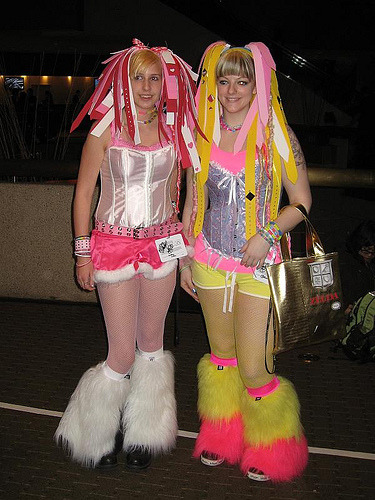 The amazing Viona Ielelegems - photographer and costumier. Features a range of historical influence in her work, including ruffs.
The amazing Viona Ielelegems - photographer and costumier. Features a range of historical influence in her work, including ruffs.
Modern Haute Couture Ruff. Gaultier, Westwood and pearls by Mikimoto. From Russian Vogue, 2010. Photographer: Sharif Hamza.
 Ruff from Russian Vogue shoot. Pearls by Mikimoto, couture by Maidon Martin and Margiola Artisani. Photographer: Sharif Hamza.
Ruff from Russian Vogue shoot. Pearls by Mikimoto, couture by Maidon Martin and Margiola Artisani. Photographer: Sharif Hamza. Lady Ga Ga wearing a ruff on a flying Piano (...of course). Ruff and latex outfit by Atsuko Kudo.
Lady Ga Ga wearing a ruff on a flying Piano (...of course). Ruff and latex outfit by Atsuko Kudo. Close up of ruff by Atsuko Kudo
Close up of ruff by Atsuko KudoWhat is a ruff? You may have seen portraits or portrayals of Queen Elizabeth wearing large cloth collars, generally white. Ahhh..those things! That's what a ruff is.
Ruffs were originally a decorative piece of material at the edge of a shirt, a small collar. Like a lot of fashion, they took on a life of their own, evolving to a larger size, and becoming a separate garment to be worn around the neck.
At their extreme they grew to be about a foot wide. They lasted about 100 years, roughly from 1550 to 1650....and lingered as clerical clothing and some cermonial dress.
More recently, Ruffs have made a reappearance with Lady Ga Ga, in some haute couture fashion, and the odd photoshoot. Design house Atsuko Kudo, who specialise in Latex wear, make Lady GaGa's ruffs. Each one uses a couple of metres of latex, because of the concertina nature of the ruff.
Gareth Pugh, like his fellow Brits Galliano and the late Alexander McQueen, takes influence from historical fashion. His spring 2009 show featured some black and white ruffs, as part of a number of ensembles.
Russian Vogue featured some Ruffs in a photoshoot of theirs - I have been trying to work out who the creator was, but my Russian isn't too good! :-). If someone can work it out, please tell me.
Ruffs are highly unlikely to be seen in the officeplace, or down the local nightclub, but can still make a fashionable presence on the catwalk and in high fashion photography...so the ruff would still be alive and kicking to some degree 500 years later.
Ruffs are highly unlikely to be seen in the officeplace, or down the local nightclub, but can still make a fashionable presence on the catwalk and in high fashion photography...so the ruff would still be alive and kicking to some degree 500 years later.








